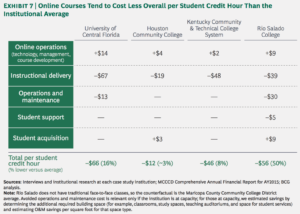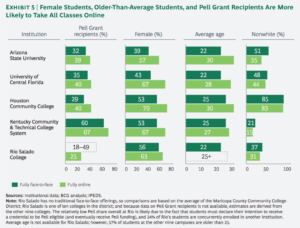On April 4th, Last week Lou Pugliese joined the Future Trends Forum to describe a forthcoming research project he’d just completed. I’d heard about the research secondhand and was intrigued. One text described it as looking into institutional return on investment (ROI) for digital learning. So I convinced Lou, senior innovation fellow and managing director technology innovation Action Lab at Arizona State University, also co-creator of Blackboard, to appear on the Forum and give the community an advance look into the report’s findings, before they were published:
I’m grateful to Lou for his generous time. (You see why the Forum is so cool?)
Here is the report. I recommend reading “Making Digital Learning Work: Success Strategies From Six Leading Universities and Community Colleges,” because this is important stuff. It is likely to be influential, even if you disagree with some of the results.
Let me pull out some highlights I found especially interesting for the future of education and technology.
The report finds three benefits for colleges and universities that get online learning right. They save money, expand access, and offer the same or better quality as face-to-face learning.
Testbed – the authors picked a very interesting mix of campuses to study. They include Arizona State University, Georgia State University, Houston Community College, the Kentucky Community and Technical College System, Rio Salado Community College, and the University of Central Florida. Note the absence of Ivies and liberal arts colleges. Instead, the focus is on higher ed sectors that reach the largest numbers of students: public universities and community colleges.
Organization – the report strongly urges centralization of services, curricula, and analysis. It refers to a portfolio approach, as in “a portfolio of digital delivery models tailored to the particular needs of different student populations.” “Strategic” is a term that resonates.
Enrollment – online learning grew the number of students at each campus or system. This isn’t a surprise, but will probably aid institutional leaders seeking to expand distance learning offerings.
Student support – Pugliese insists that direct student support services make a huge difference. In our conversation he described a range of services, including phone lines. The report refers to “a network of remotely accessible support structures”.
Diversity – the report argues that high quality online learning can yield “increases in the proportion of specific populations including Pell Grant-eligible students, older students and female students.”
About quality: the report emphasizes learning design and learning science as domains institutions must draw upon. It also recommends expanding data analytics.
Access – increasing popular access to higher education is a major theme in the report. Appropriately there’s no discussion of institutional rankings.
One detail about access: students taking online classes often had faster time to degree.
Cost savings – wholly online learning is cheaper to offer than hybrid or face to face classes, especially when factoring in larger class sizes. “[W]e found that the savings for online courses ranged from $12 to $66 per credit hour, a difference of from 3% to 50% of the average credit hour costs.” Done right, a campus can grow… revenue while reducing operating costs – a particularly important outcome in an era of declining enrollment and dwindling public subsidies for postsecondary education.
One note about this: the report praises the “emporium model” (based on Virginia Tech’s Math Emporium) as very likely to yield cost savings (13).
Adjunctification – the report openly states what higher ed has quietly known and achieved for a generation. Reducing tenure lines and growing part-time faculty saves money. At the same time the report wants faculty engagement and some degree of governance. I’m not sure how that works, unless it refers to working with a minority of tenured faculty who work part-time to manage and support adjuncts.
Third parties – there’s a cautious endorsement for institutions to draw on external for-profits at times, largely to reduce costs of building everything in-house.
Adaptive learning and open education resources – the report approves of them in principle, but finds sample sizes too small at the present.
A few additional reflections:
I wonder how the selection of test bed schools will shape the report’s influence.
(EDITED) The definition of diversity is interesting, as it picks out gender, age, and economic class, but not race so much. This may be because nonwhite learners are less likely to take online classes than white ones:
I don’t know how the report defined “nonwhite”. The term only shows up once in the report, on this chart. However, elsewhere the report finds one specific form of online learning to have an advantage for “minorities” (also undefined:
Adaptive courseware helped close achievement gaps. The use of adaptive courseware may have contributed to an observed reduction in achievement gaps for Pell Grant– eligible and minority students at Georgia State University. Minority students and Pell Grant–eligible students bene ted more from successful adaptive courseware pilots than minority and Pell Grant–eligible students enrolled in nonadaptive sections of the same courses did from their classes.
I’d really like to know more about the authors’ thinking on race and access.
If you’re interested in how they define and model ROI, head to the report’s page 15.
The Boston Consulting Group helped conduct the research. The Bill & Melinda Gates Foundation helped fund it. An advisory board included campus leaders, consultants, business executives, and association representatives. Besides Pugliese there were several other co-authors: Allison Bailey, Tyce Henry, Renee Laverdiere, Nithya Vaduganathan.
(thanks to Scott Robison for eagle-eyed reading)
[Editor’s Note: This blog was originally posted on Bryan Alexander’s blog on April 12, 2018.]
Check out this webinar
The Future Trends Forum is an open video conversation about the future of higher ed. Each week, a different guest—an inspiring expert, visionary, practitioner, or researcher—talks about their area of interest. Past guests include Audrey Watters, Martin Dougiamas, Anya Kamenetz, George Siemens, Casey Green, and Will Richardson. Check out past recordings here.
- Educause, AWS launch generative AI readiness assessment tool for higher ed - April 23, 2024
- A bungled FAFSA rollout threatens students’ college ambitions - April 19, 2024
- Using real-world tools to prepare students for the workforce - April 18, 2024



